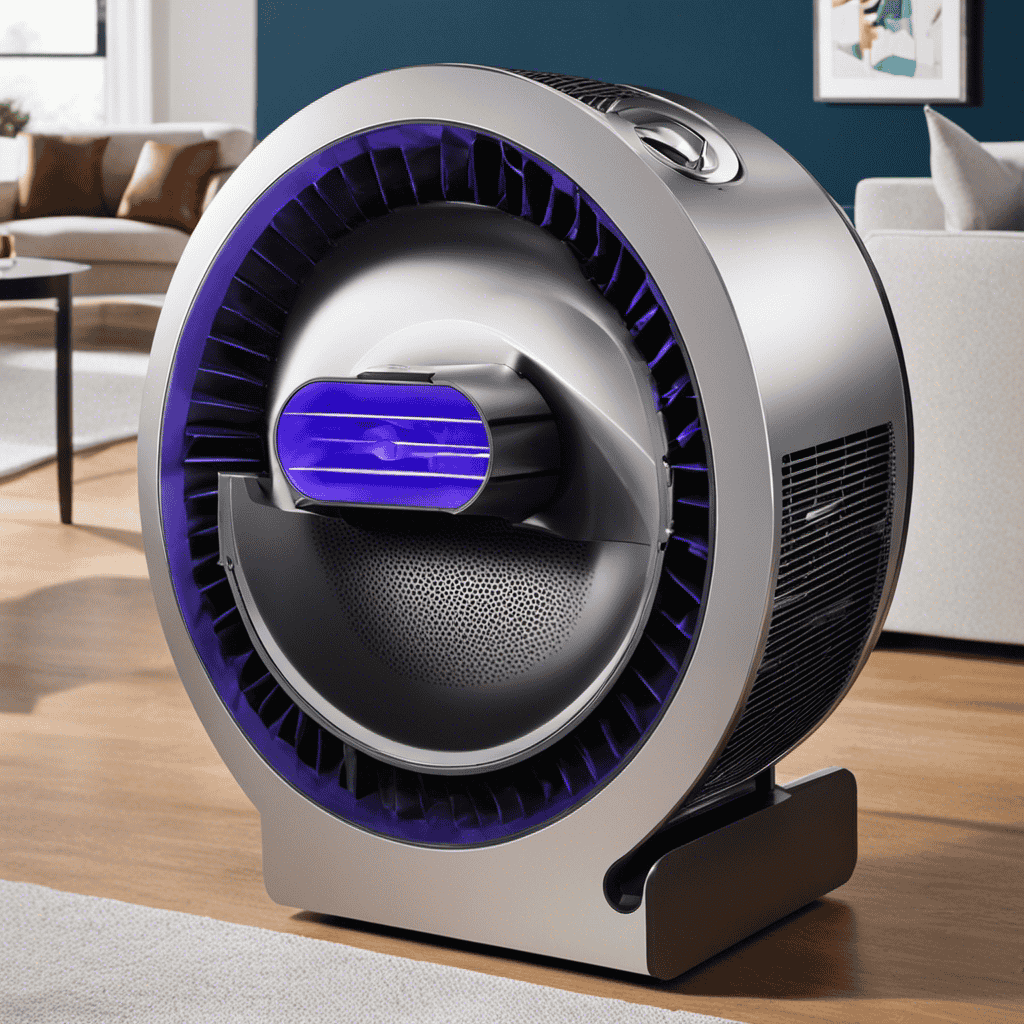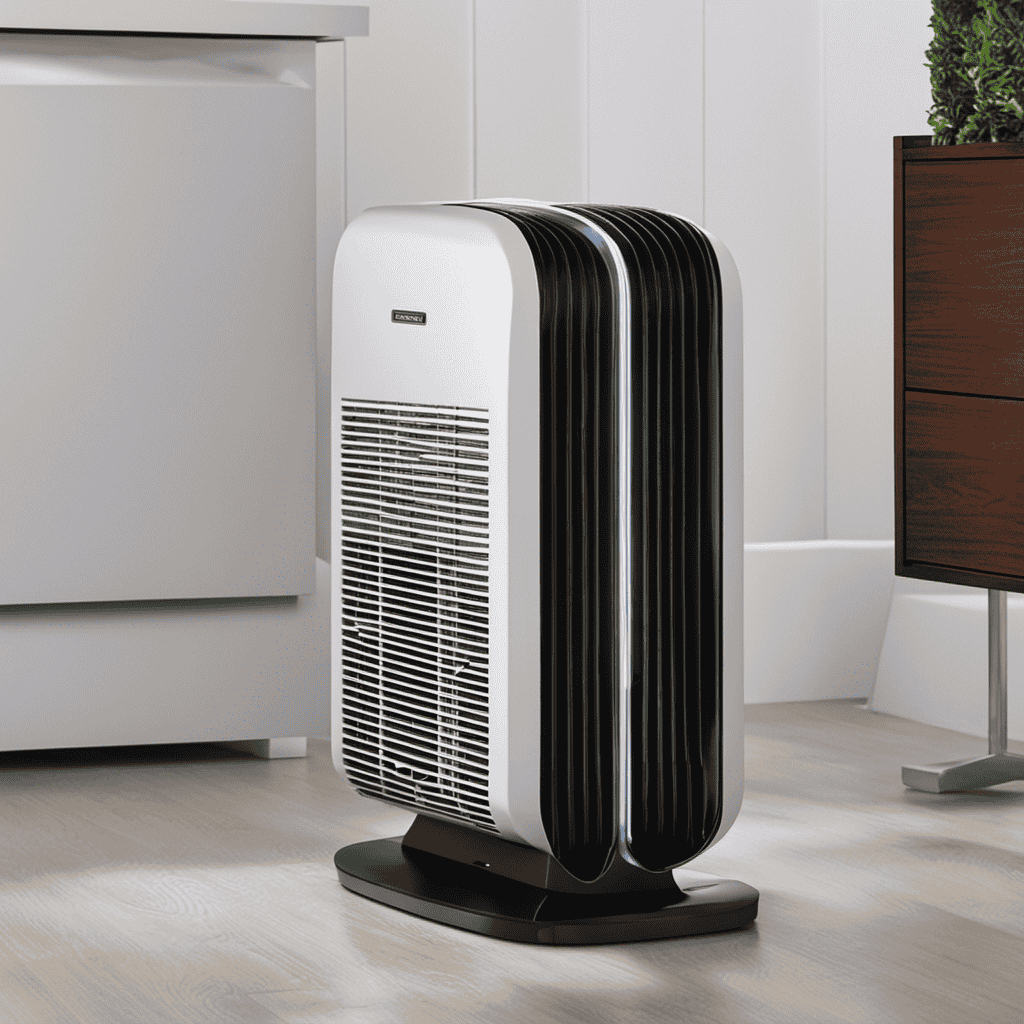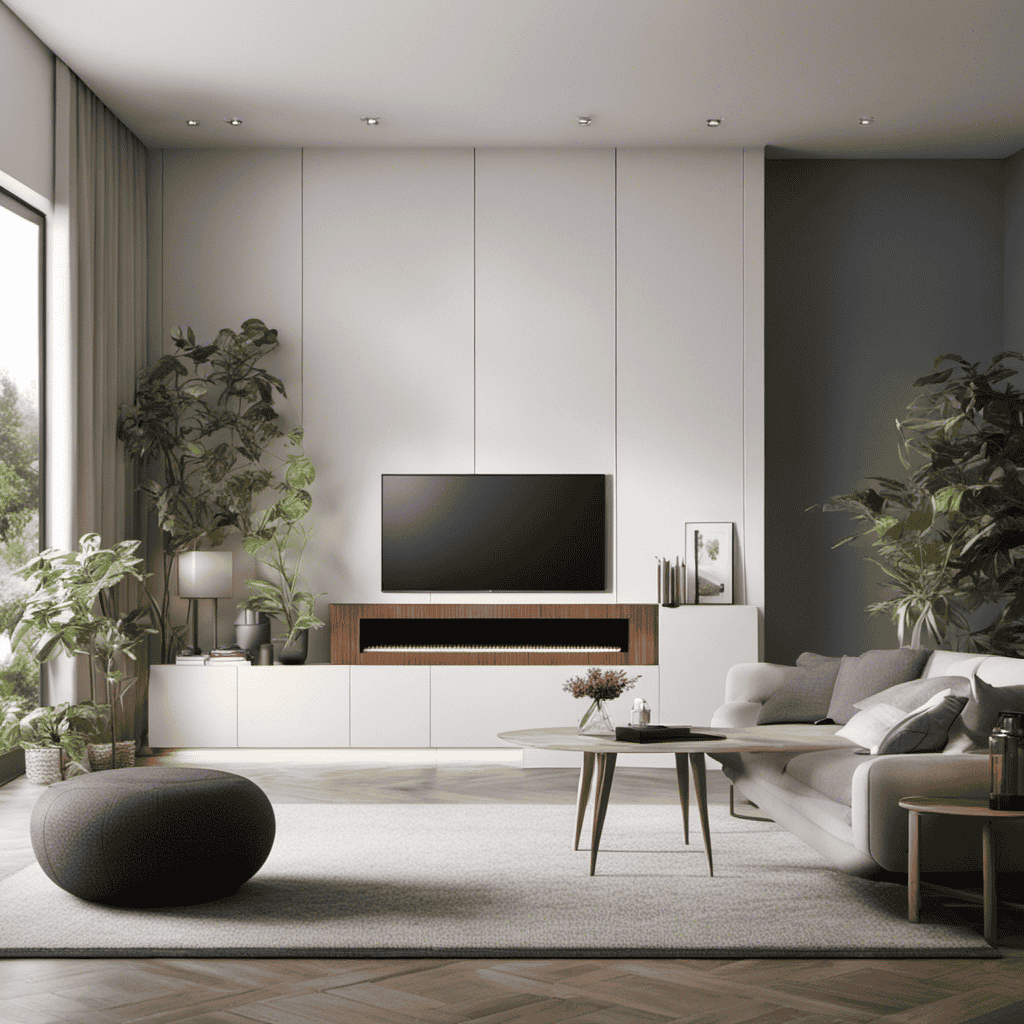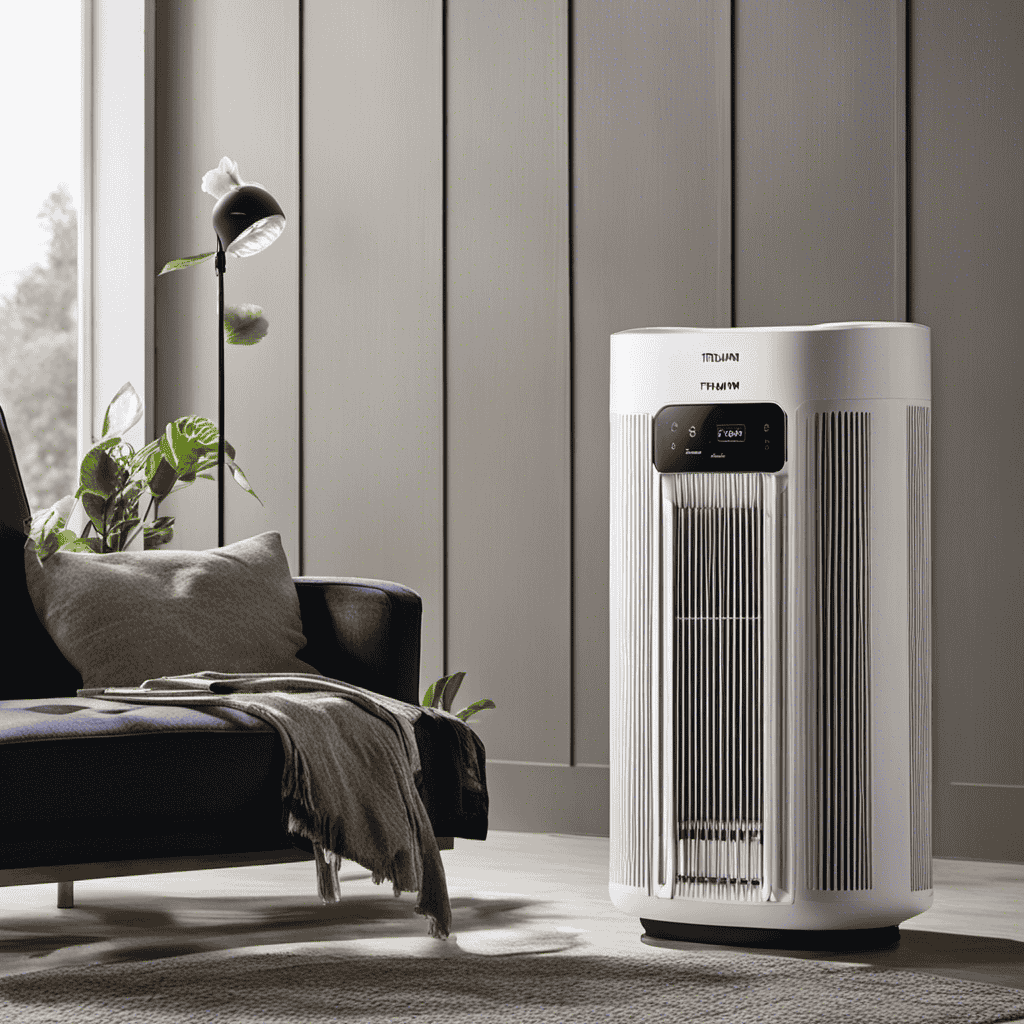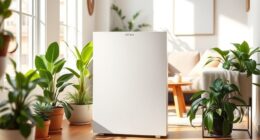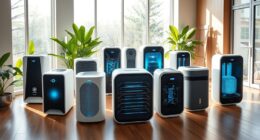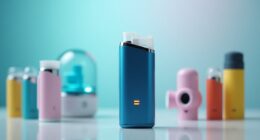I’ve always been intrigued by the workings of air purifiers. They appear to be like enchanting devices that have the ability to cleanse the air surrounding us. However, being someone who pays close attention to details and is analytical in nature, I was keen on delving deeper to comprehend the scientific principles behind their operation.
So, in this article, I will break down the different types of air purifiers and their filtration process. Get ready to dive into the world of air purification and discover the amazing benefits it can bring to our health.
Key Takeaways
- Air purifiers use different technologies such as HEPA filtration, activated carbon filtration, UV light, and ionization to remove various pollutants from the air.
- The air purification process involves multiple stages, including pre-filtering, HEPA filtration, activated carbon filtration, UV-C light treatment, and ionization.
- Regularly replacing filters is crucial for maintaining the effectiveness of air purifiers.
- Air purifiers provide numerous benefits, including the removal of allergens, bacteria, viruses, and odors, leading to improved respiratory health and a cleaner indoor environment.
Types of Air Purifiers
There are several types of air purifiers available in the market today. Each type offers unique features and benefits to improve indoor air quality.
One common type is the HEPA (High-Efficiency Particulate Air) purifier. It uses a dense filter to trap tiny particles like dust, pollen, and pet dander, making it ideal for people with allergies or asthma.
Another type is the activated carbon purifier, which uses a porous material to absorb odors, chemicals, and VOCs (volatile organic compounds).
UV (Ultraviolet) purifiers use UV light to kill bacteria, viruses, and mold spores. These purifiers are great for preventing the spread of illnesses.
Lastly, there are ionizers that release negative ions to attach to airborne particles and make them fall to the ground. This type is effective in removing allergens and pollutants from the air.
Understanding the different features and benefits of each type can help you choose the right air purifier for your specific needs.
Filtration Process
To filter out pollutants, you’ll need to replace the air purifier’s filters regularly. Proper air purifier maintenance is crucial to ensure optimal performance and clean air in your space. Over time, the filters in an air purifier can become clogged with dust, allergens, and other particles, reducing their effectiveness. Regularly replacing the filters is essential to maintain the purifier’s efficiency and prolong its lifespan.
Air purifier technology advancements have led to the development of more efficient and effective filtration systems. Here are three key advancements in air purifier technology:
-
High-Efficiency Particulate Air (HEPA) filters: These filters can capture particles as small as 0.3 microns, effectively removing allergens, dust, and other pollutants from the air.
-
Activated carbon filters: These filters are designed to remove odors, gases, and volatile organic compounds (VOCs) from the air by adsorbing them onto the carbon surface.
-
Ultraviolet (UV) germicidal irradiation: This technology uses UV-C light to kill bacteria, viruses, and other microorganisms, providing an additional layer of protection against airborne pathogens.
By regularly replacing filters and taking advantage of these technological advancements, you can ensure that your air purifier continues to provide clean and healthy air in your indoor environment.
Now, let’s delve into the pre-filter stage and its importance in the filtration process.
Pre-Filter Stage
Make sure you regularly clean and replace the pre-filter to ensure optimal performance and clean air in your space.
The pre-filter is an essential component of an air purifier that plays a crucial role in the filtration process. Its main function is to capture larger particles such as dust, pet hair, and lint, preventing them from clogging the subsequent stages.
By removing these larger particles, the pre-filter not only enhances the overall efficiency of the air purifier but also prolongs the lifespan of the other filters, like the HEPA filter.
This maintenance step is vital because a clogged or dirty pre-filter can hinder the airflow and reduce the effectiveness of the air purification system.
Therefore, by regularly cleaning or replacing the pre-filter, you can ensure that your air purifier continues to deliver clean and fresh air in your space.
Now, let’s move on to the next stage, the HEPA filter.
HEPA Filter Stage
The HEPA filter is responsible for capturing smaller particles, such as pollen, smoke, and bacteria, ensuring cleaner and healthier air. This highly efficient filter is a key component of an air purifier, and its maintenance is crucial for optimal performance.
Regularly replacing the HEPA filter is essential to maintain its effectiveness. Over time, the filter becomes clogged with trapped particles, reducing its ability to capture airborne pollutants. A clogged filter not only compromises air quality but also puts extra strain on the air purifier’s motor, leading to decreased efficiency.
To maximize the lifespan of the HEPA filter, it is recommended to follow the manufacturer’s instructions for filter maintenance and replacement. By properly maintaining the HEPA filter, you can ensure that your air purifier continues to provide clean and healthy air for you and your family.
Activated Carbon Filter Stage
Regularly replacing the activated carbon filter is important for removing odors and harmful gases from the air you breathe. The activated carbon filter is a crucial component of an air purifier, known for its effectiveness in trapping and adsorbing various contaminants.
The benefits of using an activated carbon filter are numerous. It has the ability to eliminate unpleasant smells caused by pet dander, cooking, or tobacco smoke. Additionally, it can effectively capture volatile organic compounds (VOCs), such as formaldehyde and benzene, which are commonly found in household products and can be detrimental to our health.
The activated carbon filter works by utilizing a process called adsorption, where the contaminants are attracted to and trapped within the porous surface of the carbon. This filtration stage significantly improves the overall air quality, making it safer and more enjoyable to breathe.
UV-C Light Stage
Using UV-C light is an effective method for neutralizing harmful bacteria and viruses in the air. UV-C light works by damaging the DNA or RNA of microorganisms, preventing them from reproducing and rendering them inactive. This stage in the air purification process is crucial for ensuring a clean and healthy environment.
Here are some key points about the safety and effectiveness of UV-C light:
- UV-C light is a proven technology used in hospitals and laboratories for disinfection purposes.
- It is safe for humans when used in controlled environments and following recommended guidelines.
- UV-C light can effectively eliminate up to 99.9% of airborne pathogens, including influenza, rhinovirus, and E. coli.
The UV-C light stage plays a vital role in removing harmful microorganisms from the air, creating a safer and healthier indoor environment.
Transitioning to the next stage, let’s explore the ionization stage and its benefits.
Ionization Stage
After the air passes through the UV-C light stage, it moves on to the ionization stage. In this stage, the air purifier uses an ionization process to further improve air quality.
Ionization is the process of adding or removing electrons from atoms or molecules, creating charged particles called ions. In the case of an air purifier, it produces negative ions. These negative ions are released into the air and attach themselves to airborne particles, such as dust, pollen, and pet dander. Once attached, the particles become heavier and fall out of the air, reducing their concentration in the environment.
This process helps to remove harmful pollutants and allergens from the air, making it cleaner and healthier to breathe. The ionization stage is an important component of the air purifier’s overall effectiveness in improving indoor air quality.
Ozone Generation
To generate ozone, you can adjust the settings on the air purifier. Ozone is a powerful oxidizing agent that can effectively eliminate odors and kill bacteria in the air. However, it is important to use caution when generating ozone as it can be harmful to humans and other living organisms. Ozone safety should always be a top priority.
To ensure safe ozone levels, air purifiers are designed with ozone emission limits. These limits are set to prevent excessive ozone production that could pose health risks. It is crucial to follow the manufacturer’s instructions and guidelines when using an air purifier that generates ozone.
Here are some key points to keep in mind regarding ozone safety:
- Always use the air purifier in a well-ventilated area to minimize ozone concentration.
- Avoid prolonged exposure to high ozone levels.
- Regularly monitor ozone levels and ensure they remain within safe limits.
Air Circulation
One important aspect of air circulation is ensuring proper ventilation to maintain a healthy indoor environment. Indoor air quality plays a crucial role in our overall well-being, and having clean air is essential for our health.
Proper air circulation helps to remove pollutants and allergens from the indoor environment, improving the overall air quality. When the air is stagnant and not properly circulated, it can lead to the buildup of harmful substances such as dust, mold, and volatile organic compounds (VOCs). These pollutants can cause respiratory problems, allergies, and other health issues.
CADR (Clean Air Delivery Rate
The CADR rating indicates how effectively an air purifier removes pollutants from the indoor environment. It is an important measure to consider when choosing an air purifier for your home or office. A higher CADR means that the air purifier is more efficient in removing pollutants such as dust, pollen, and smoke.
A higher CADR rating means cleaner air in a shorter amount of time. Air purifiers with a higher CADR can provide significant health benefits by reducing exposure to harmful particles. The CADR rating is determined through rigorous testing in controlled environments, ensuring accuracy and reliability.
Noise Level
Consider the noise level of the air purifier, as it can affect your overall comfort and the peacefulness of your living or working space. When choosing an air purifier, it’s important to prioritize noise reduction, especially if you plan to use it in your bedroom or office where you need a quiet environment for sleep or concentration. The noise level of an air purifier is measured in decibels (dB), with lower dB values indicating a quieter operation. To help you understand the noise levels, here is a comparison table showing different noise levels and their corresponding everyday sounds:
| Noise Level (dB) | Common Sounds |
|---|---|
| 30 dB | Whispering |
| 50 dB | Rainfall |
| 70 dB | Vacuum Cleaner |
Power Consumption
When it comes to energy efficiency levels, it’s important to consider the impact they can have on our electricity bills.
By analyzing the energy consumption of different appliances and devices, we can make informed decisions to reduce our energy usage and save money.
Understanding the relationship between energy efficiency and electricity bills is crucial in promoting sustainable practices and minimizing our environmental impact.
Energy Efficiency Levels
Did you know that air purifiers with higher energy efficiency levels can help you save on electricity bills? When it comes to energy saving, choosing an air purifier with a high energy efficiency rating is crucial.
Here are three reasons why:
-
Lower power consumption: Air purifiers with high energy efficiency levels use less electricity compared to less efficient models. This means lower energy bills and reduced environmental impact.
-
Longer lifespan: Energy-efficient air purifiers are often built with high-quality components, resulting in a longer lifespan. This means you won’t have to replace your air purifier as frequently, further reducing your environmental footprint.
-
Eco-friendly features: Many energy-efficient air purifiers come with eco-friendly features, such as programmable timers and sleep modes. These features help optimize energy consumption and minimize unnecessary power usage.
Impact on Electricity Bills
Investing in an air purifier with higher energy efficiency levels can significantly lower your electricity bills. Not only will you be able to enjoy clean and fresh air, but you will also save money in the long run. Air purifiers consume electricity to operate their fans, filters, and sensors. However, some models are more energy-efficient than others, meaning they use less electricity to achieve the same level of air purification. To help you make an informed decision, here is a table comparing the energy efficiency levels of different air purifiers:
| Air Purifier Model | Energy Efficiency Rating |
|---|---|
| Model A | High |
| Model B | Medium |
| Model C | Low |
| Model D | High |
Investing in a high-energy efficiency air purifier not only reduces your impact on the environment but also lowers your long-term cost. By using less electricity, these purifiers help you save money on your electricity bills while efficiently improving the air quality in your home. Moreover, energy-efficient air purifiers have a positive impact on your health by removing harmful pollutants from the air you breathe. So, make a smart choice and choose an air purifier that not only benefits your health but also saves you money in the long run.
Maintenance and Filter Replacement
To keep your air purifier running efficiently, you’ll need to regularly maintain it and replace the filters. Maintaining your air purifier is crucial for optimal performance and to ensure that it effectively removes pollutants from the air. Here are some maintenance tips to follow:
- Clean the exterior regularly to remove dust and dirt buildup.
- Check the manufacturer’s instructions for specific cleaning recommendations.
- Replace the filters as recommended by the manufacturer to maintain the purifier’s effectiveness.
Regular filter replacement offers several benefits. Firstly, it ensures that the air purifier continues to remove airborne contaminants effectively. Secondly, clean filters improve the overall indoor air quality, reducing the risk of respiratory issues. Lastly, regular filter replacement can extend the lifespan of your air purifier, saving you money in the long run.
Effectiveness in Removing Pollutants
In my previous subtopic, I discussed the importance of maintenance and filter replacement for air purifiers. Now, let’s delve into the effectiveness of these devices in removing pollutants. When it comes to improving indoor air quality, air purifiers are a cost-effective solution with long-term benefits. They work by drawing air through a series of filters that capture and trap airborne particles and pollutants. To understand their effectiveness, let’s look at a comparison table:
| Air Pollutant | Air Purifier Efficiency |
|---|---|
| Dust | 99% |
| Pollen | 98% |
| Pet Dander | 99% |
| Mold Spores | 99.9% |
| Smoke | 95% |
As you can see, air purifiers are highly efficient in removing a wide range of pollutants. Investing in an air purifier not only ensures cleaner air but also offers long-term benefits by reducing the risk of respiratory issues and improving overall well-being.
Health Benefits of Using an Air Purifier
If you’re concerned about your respiratory health and want to breathe cleaner air, using an air purifier can provide significant health benefits. Air purifiers are designed to remove pollutants and allergens from the air, creating a healthier indoor environment.
Here are three key ways that air purifiers can improve your respiratory health:
-
Reduction in Allergens: Air purifiers are highly effective at capturing airborne allergens such as pollen, dust mites, and pet dander. By removing these allergens from the air, air purifiers can help alleviate allergy symptoms and provide relief for those suffering from allergies.
-
Removal of Airborne Particles: Air purifiers work by using filters to capture and trap airborne particles, including bacteria, viruses, and mold spores. This can help reduce the risk of respiratory infections and improve overall respiratory health.
-
Elimination of Odors: Air purifiers with activated carbon filters can also eliminate unpleasant odors from the air, such as those caused by cooking, pets, or smoke. This can create a fresher and more pleasant indoor environment.
Frequently Asked Questions
How Much Electricity Does an Air Purifier Consume on Average?
On average, an air purifier consumes a moderate amount of electricity. Factors such as the size of the unit, fan speed settings, and usage time impact its electricity usage.
Are Air Purifiers Effective in Removing Pet Dander and Allergens?
Air purifiers can be effective in removing pet dander and allergens, providing relief for asthma and allergy sufferers. I’ve researched the benefits and found that they help improve indoor air quality by capturing and filtering these irritants.
Can Air Purifiers Help Reduce the Spread of Airborne Viruses?
Yes, air purifiers can help reduce the spread of airborne viruses. They filter out particles and pollutants, improving respiratory health. Using air purifiers during flu season has the added benefit of minimizing exposure to viruses.
How Often Should the Filters in an Air Purifier Be Replaced?
I replace the filters in my air purifier so often, it’s like a never-ending cycle! But it’s worth it to have clean air in my home. It’s important to choose the right purifier and enjoy the benefits, especially in the bedroom.
Are There Any Potential Health Risks Associated With Using an Air Purifier for Prolonged Periods of Time?
There may be potential side effects and long-term health effects associated with using an air purifier for prolonged periods of time. It is important to understand and mitigate any risks before using one.
Conclusion
In conclusion, the marvels of air purifiers never cease to amaze me. These little contraptions, with their intricate filtration processes, diligently rid our homes of pesky pollutants.
It’s almost like having a personal air superhero, fighting the invisible villains that threaten our health. And let’s not forget the joy of constantly replacing filters and monitoring power consumption, because who doesn’t love a good chore?
So, embrace the scientific wonder of air purifiers and revel in the irony of enjoying clean air through a man-made device.



